Riemann zeta function
The Riemann zeta function, also known as the Riemann ζ-function or Riemann zeta function (after Bernhard Riemann), is a complex-valued, special mathematical function that plays an important role in analytical number theory, a branch of mathematics. It was first considered in the 18th century by Leonhard Euler, who investigated it within the framework of the Basel problem. It is usually denoted by the symbol 

For values 

Of great importance for number theory is that the zeta function expresses the law of the unique decomposition of natural numbers into prime factors (by this is meant the decomposition of a number into "indivisible" elements, approximately 132 = 2 - 2 - 3 - 11) analytically, i.e. through a closed formula. On this basis, Riemann was able to prove in 1859 the very close and non-obvious relationship between the prime numbers and the position of the zeros of the zeta function. Thus, it follows from the fact 




Here denotes 


The behaviour of the Riemann zeta function is valid in the ranges 



From the point of view of algebraic number theory, the Riemann zeta function is only a special case of a whole class of so-called L-functions. Thus it corresponds to the Dirichlet L-function belonging to the trivial character modulo 1 and to the number field 
Because of the paramount importance of the Riemann conjecture for number theory and its applications, the subject of the Riemann zeta function remains an area of intensive mathematical research. Decisive progress was made by mathematicians such as Lindelöf, Hadamard, de La Vallée Poussin, Hardy, Littlewood, Selberg, Woronin and Conrey.
Notation: Throughout the article, denotes 


Furthermore, Landau's O-notation is often used for the specification of error sizes. If two (unrestricted) functions 




Complex diagram with colouring of the function values: The Riemann zeta function in the complex plane: The zero, i.e. the origin of the complex plane, is located exactly in the middle of the diagram. The so-called non-trivial zeros of the zeta function visible in the picture lie on the vertical line through 0.5 that is not drawn in. They are recognisable as black points on this imaginary line and are arranged in mirror symmetry to the real axis, i.e. to the horizontal line through the origin. The diagram has a single pure white point. This belongs to the only pole of the zeta function in 1, i.e. to that point which is one unit to the right of the origin and in which the zeta function is not defined. The so-called trivial zeros lie on the left part of the real axis, namely in -2, -4, -6, -8 ...
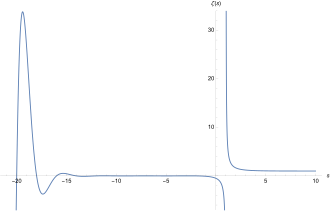
Function graph of the zeta function for real arguments in the range -20 < s < 10
Classification without prior mathematical knowledge
Motivation
At the centre of number theory, that branch of mathematics that deals with the properties of the natural numbers 1, 2, 3, 4 ... are the prime numbers 2, 3, 5, 7, 11 ... These are distinguished by the property of having exactly two divisors, namely 1 and themselves. 1 is not a prime number. Euclid was already able to show that there are an infinite number of prime numbers, which is why the list 2, 3, 5, 7, 11 ... will never end.
The prime numbers are, in a sense, the atoms of the integers, since every positive integer can be unambiguously decomposed into such multiplicatively. For example, 21 = 3 - 7 and 110 = 2 - 5 - 11. Despite this elementary property, after several millennia of mathematical history, there is still no known simple pattern to which the prime numbers conform in their sequence. Their nature is one of the most important open questions in mathematics.
Even if the detailed understanding of sequence 2, 3, 5, 7, 11 ... is unattainably distant, one can look for patterns if one broadens one's view. This is helped, for example, by the idea that statistical methods can often be used to describe the behaviour of a very large number of people (for example, with regard to consumption and voting behaviour) with surprising precision, although a single person is extremely complex. Roughly speaking, this has to do with the fact that increasing amounts of relevant data provide ever more reliable information. In the case of prime numbers, such an expansion leads, among other things, to the question of how many prime numbers there are below a fixed chosen number.
For example, only 4 prime numbers, namely 2, 3, 5 and 7, are smaller than the number 10. In the case of 50, there are already 15 smaller prime numbers, namely
At the end of the 19th century, an amazingly accurate estimate for the distribution of prime numbers was proven as a corollary of the prime number theorem. The prime number theorem was already conjectured in the 18th century by the 15-year-old Gauss (in 1792/93). The estimation was already given before a proof of the prime number theorem by Riemann and appears as a formula that allows the quick calculation of a predicted value. With this formula, for a given number, the number of primes smaller than this number can be estimated in a reasonable time. The formula for prediction becomes more accurate in percentage terms the larger the number is chosen (but with fluctuations). For example, for the value 50 it gives the prediction 14.97 (there are actually 15 primes, see above), making the error 0.16 per cent. Further, it predicts about 78,527 primes below the number 1,000,000 - in fact there are 78,498. This corresponds to a deviation of 0.037 per cent.
One possible tool for proving this formula is the Riemann zeta function. This takes advantage of the fact that it expresses the law of unique prime factorisation in the language of analysis. So the properties of the prime numbers are stored hidden in this function. If the knowledge of the zeta function increases, so does the knowledge of the prime numbers, even in more detailed questions. In this way, many prime number tests, such as Miller-Rabin's, can be proven or improved by assuming the Riemann conjecture.
The zeros of the zeta function generate a correction term of the above formula, which converts it into an exact expression. The resulting exact formula thus knows the distribution of the prime numbers down to the last detail. However, this does not mean that the questions about the prime numbers have been solved: the computational effort increases very strongly with increasing values and thus practical calculations with this formula are not effective. In contrast, modern prime number tests are better suited for numerical research. The exact formula, however, is of theoretical interest: namely, it conceals the error gap between the simple prediction and the actual prime number distribution. It is assumed that this error (within the spectrum of all possibilities) is the smallest possible. Yet deciphering this error would not be so much relevant to numerics. Rather, pure mathematics strives to find out the hitherto hidden reason why the error (if applicable) turns out to be as small as possible.
Prime numbers are not only the subject of basic mathematical research, but also have practical applications. For example, cryptosystems such as RSA encryption use very large prime numbers.
How does the Zeta function "work"?
A mathematical function is basically like a calculating machine. You enter a value into the function and it then delivers a result depending on the input value, at least in theory. What is meant by this is that the function itself does not calculate, but usually only records a calculation rule in the form of a formula. A simple example of a function is the quadratic function, which multiplies the input by itself. This is written formulaically as 




In principle, the Riemann zeta function works exactly like the example above, except that the calculation rule is a little more complicated. To understand it, the concept of infinite series must be known. A (convergent) series is, roughly speaking, a sum of numbers that never ends and that gets closer and closer to a number. An elementary non-trivial example of a series is based on the number 
can be written. If you look more closely, you see that this is just the sum of all reciprocal powers of 10:
In order for the infinitely long sum to approach a value, it must be ensured that the summands become small "fast enough".
The Riemann zeta function can now be compared to a calculating machine which, for a given number 

To understand this better, consider the example of the input 
It turns out that the expressions 
and if you even 
Since a lot of terms have already been added here, one can assume that 

Here π is 





For each prime number, the counting function takes one step up an infinitely long and high staircase. The prediction "meanders" steadily around the counting function. However, for very large values, an ever greater distance between the staircase and the prediction is to be expected.
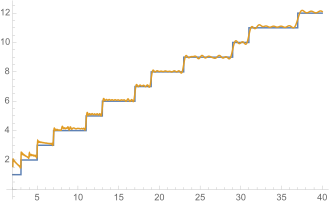
The zeros of the zeta function correct the prediction to an exact term. The more of the infinitely many zeros are included, the more accurate the approximation. The picture shows the correction of 100 pairs of zeros.
History
In contrast to prime numbers or Euclidean geometry, the mathematical history of the discovery of the Riemann zeta function is very young. Thus, all the discoveries concerning this function that are still significant today were made in the last 250 years. On the one hand, the early discovery in relation to the emergence of rigorous (complex) analysis can be justified by the simplicity of the series. On the other hand, the late results can be explained by the difficulty of their properties.
Around 1735 Leonhard Euler solved the Basel problem
One of the first mathematicians to deal intensively and in detail with a precursor of the zeta function as defined today was Leonhard Euler. Since the middle of the 17th century, mathematicians had been trying to find the exact limit of the infinite series.
to determine. Personalities such as Pietro Mengoli, who formulated the Basel problem (as it was later called) for the first time, but also Jakob I Bernoulli failed with their attempts to solve it. It was not until around 1734 that Leonhard Euler found the solution.
with the circle number π 
interested. He had the hope of being able to make further and, moreover, far more significant statements. And indeed, it was not to remain only with the solution of the Basel problem. Among other things, he found the formulas
which were first published in 1735 in his work De Summis Serierum Reciprocarum. Although the function values become more complicated with increasing input numbers, Euler calculated the value by hand
In his book Institutiones calculi differentialis cum eius usu in analysi finitorum ac doctrina serierum, published in 1755, he finally proved a general formula for 


because none of his techniques could be applied here. However, he calculated the values 







Euler is considered the discoverer of the link between the zeta function and the prime numbers. This link is still called the Euler product today. Thus he wrote in his work Variae observationes circa series infinitas:
"If the following expression is formed from the series of prime numbers
, its value will be equal to the sum of this series
“
- Leonhard Euler
Immediately Euler was aware of the relationship between prime numbers and geometry, and he continued writing:
"Because after setting
holds
, where π
denotes the periphery of the circle whose diameter is 1, will be
“
- Leonhard Euler
From the fact, already well known at that time, that the harmonicseries is divergent, Euler was also able to conclude from the Euler product that the sum of the reciprocals of all prime numbers has no finite limit. This result is also known as Euler's theorem on the summation of the reciprocals of the primes.
The functional equation later proved by Riemann was also already known to Euler. In his work Remarques sur un beau rapport entre les series des puissances tant directes que reciproques, he described it in a mathematically non-rigorous way:
"Par cette raison je hazarderai la conjecture suivante, que quelque soit l'exposant n, cette équation ait toujours lieu:
“
"For this reason I venture to suggest the following conjecture that for any variable n the following the equation is always valid:
“
- Leonhard Euler
Euler was actually referring to Dirichlet's eta function, which, however, corresponds to the Riemann zeta function except for one factor. Euler did not give a rigorous proof of a functional equation, but had only checked it for many values and then assumed it to be universally valid.
Dirichlet shows his prime number theorem
In 1838, the mathematician Peter Dirichlet made a major contribution to number theory. He proved a conjecture of Fermat, which is now called Dirichlet's prime number theorem. This states that every arithmetic progression 



The key to the proof was, in addition to the Riemann zeta function, a whole class of other functions that also decompose into prime products and thus form a "large family". Only a century later, thanks to finer methods, Dirichlet's results could be clearly specified by Siegel and Walfisz (Siegel-Walfisz theorem).
Riemann's contribution to the zeta function
In 1859, Bernhard Riemann decisively elaborated the connection of the zeta function to the prime numbers already given by Euler in his publication Über die Anzahl der Primzahlen unter einer gegebenen Größe. The great achievement was to recognise the relevance of extending the domain of definition to complex numbers. Only with this approach had it become possible to gain concrete information about primes 2, 3, 5, 7 ... themselves. This is remarkable insofar as prime numbers are real numbers. Riemann, who was a student of Carl Friedrich Gauss, wrote a function-theoretical interpretation and evaluation of the Euler product in his ten-page paper, which created a connection between prime numbers and the non-trivial zeros of the zeta function. The main result was a formula that counted the number of prime numbers under a given (non-integer) positive number without any error. With this, he had managed a completely new approach to the theory of prime numbers.
In his work he established the Greek 
Although the article is nowadays seen as a breakthrough and departure for modern analytical theory around the zeta function, it was far from being met with enthusiasm in mathematical circles at the time. This was primarily due to the fact that Riemann had omitted to provide proofs for his formulas in most places. As a result, Godfrey Harold Hardy and John Edensor Littlewood described Riemann's work merely as a "remarkable collection of heuristic insights", although English mathematicians were still so backward in analytical number theory at the beginning of the 20th century that Littlewood remembered being given Riemann's conjecture as an exercise by his professor in 1906. Edmund Landau was also among the most vocal critics regarding the meaning of the article. Although he initially called it "brilliant and fruitful", his praise soon changed:
"Riemann's formula is by no means the most important thing in the theory of prime numbers. He created some tools which, once worked out, will make some other proofs possible."
- Edmund Landau
Detlef Laugwitz notes in his Riemann biography that Landau also paid little tribute to Euler's groundbreaking work in his textbooks, as he tended to appreciate only work in which every detail was worked out. On the other hand, mathematicians like Felix Klein admired that Riemann had worked "with great general ideas" and "often relied on his intuition". That was even before Carl Ludwig Siegel's study of the estate showed how extensive Riemann's analytical work on the zeta function was. The calculations in the estate were difficult to decipher, however, and it took a mathematician of Siegel's calibre to reconstruct Riemann's ideas.
Riemann did not work on the zeta function again from this time until his early death (he died of tuberculosis at the age of just 39); it remained his only publication on number theory. The 1859 essay was only sketchy; Riemann wanted to thank the Berlin Academy of Sciences for admitting him.
Many of Riemann's records were burned by his housekeeper after his demise until she was stopped by members of the Göttingen faculty. The remaining writings were handed over to his widow and thus disappeared for many years. To this day, we can only speculate about further results on the Zeta function that would have been found if the documents had not been partially destroyed.
The last years of the 19th century
Mangoldt proves Riemann's main formula
In 1893, the mathematician Jacques Hadamard published a paper that laid the foundation for a more detailed understanding of Riemann's work. Hadamard had succeeded in proving a formula for the zeta function that included its zeros. Strictly speaking, this was a procedure for constructing the zeta function as a whole from its zeros. The existence of such a formula had already been assumed by Riemann, but had not been rigorously proved until then. For the verification of Riemann's ideas, however, it was a substantial part: the basic scheme of argumentation for Riemann's main formula was namely "prime product (Euler) versus zero product (Riemann/Hadamard)". For this reason, among others, Hans von Mangoldt called Hadamard's contribution "the first real progress in this field for 34 years".
Building on Hadamard's work, Hans von Mangoldt made the breakthrough to Riemann's main formula only two years later, in 1895. However, he showed it in a slightly modified version that is considered more "natural" today. In honour of his achievement, the main formula is now called the Riemann von Mangoldt formula.
Hadamard and De La Vallee-Poussin prove the prime number theorem
After von Mangoldt proved Riemann's main formula in 1895, not much was needed to prove the prime number theorem. This theorem makes a statement about how often prime numbers appear on average. All that remained was to show that the zeta function has no zeros in the range in which Euler's prime number product is "just not valid any more". Independently, Hadamard and the Belgian Charles-Jean de La Vallée Poussin produced the proof in 1896. Important points for the proof were ideas of Franz Mertens and the trigonometric identity 
Although there was great excitement in the mathematics world, there were concerns about the naturalness of the method of proof, which was strongly tied to the properties of the difficult zeta function. It was considered strange that a statement about prime numbers was even equivalent to a certain distribution of the zeros of a complex function. Thus Albert Ingham expressed in 1932:
"One may consider the proof of the prime number theorem, [...] of de la Vallée Poussin and Hadamard unsatisfactory, because terms are introduced which are very far from the original problem. Therefore it is only too natural to ask for a proof which does not depend on the theory of functions of a complex variable. To this we must reply that at present no such proof is known. Indeed, we may go further and say that it is unlikely that a truly real proof will be found; at least it is unlikely so long as the theory relies on the Eulerian identity. For every known proof of the prime number theorem relies on some property of the complex zeros of
and, conversely, this property is a simple corollary of the prime number theorem itself. It seems clear, therefore, that this property must be used explicitly or implicitly in any proof
based on and one does not see how a proof is to be given using only the real values of
"
- Albert Ingham
In 1948, an elementary proof (i.e. one that does not require any functional theory) was finally given by Atle Selberg and Paul Erdös. However, "elementary" does not mean "simple". In the course of time, considerably simpler function-theoretic and elementary proofs of the prime number theorem were found.
Beginning of the 20th century
Hilbert formulates his 23 problems
→ Main article: Hilbert problems
David Hilbert gave a lecture on 8 August at the 2nd International Congress of Mathematicians in Paris in 1900. In it, he formulated a list of 23 mathematical problems that he considered to be among the most important of the coming century. At that time, Hilbert was already one of the leading mathematicians of the day. Problem No. 8 was the Riemann conjecture:
"In the theory of the distribution of prime numbers, considerable progress has been made in recent times by Hadamard, De La Vallee-Poussin, V. Mangoldt and others. However, for the complete solution of the problems posed to us by Riemann's treatise 'On the Number of Primes under a Given Quantity', it is still necessary to prove the correctness of Riemann's extremely important assertion that the zeros of the function
represented by the series all have the real component
- if one disregards the known negative integer zeros. As soon as this proof is successful, the further task would be to test the Riemann infinite series for the number of primes more precisely and, in particular, to decide whether the difference between the number of primes below a magnitude and the integral logarithm of }
does indeed
become infinite of no higher than the
{1}{2}}th order in and further, whether then the members of Riemann's formula depending on the first complex zeros of the function
really cause the local compression of the primes which has been noticed in the counts of the primes.“
- David Hilbert
The high reputation Hilbert enjoyed inspired mathematicians to tackle his problems, including the zeta function. To date, 15 of the 23 problems are considered solved, but not the Riemann conjecture.
Ramanujan's work on the zeta function
In 1910, the Indian mathematician Srinivasa Ramanujan published an article in the Journal of the Indian Mathematical Society in which, among other things, the following equation was asserted:
Most mathematicians who had seen this equation had judged it to be obvious nonsense. So it was that Professor Hill of University College in London wrote:
"Mr Ramanujan has become a victim of the pitfalls of the very difficult field of divergent series."
- Micaiah John Muller Hill
Hill, however, was not completely dismissive and encouraged Ramanujan to keep trying. And so he sent his results directly to some mathematicians at Cambridge. Two of them were unable to recognise the statements behind Ramanujan's coded formulae and refused the request for assistance. However, when Ramanujan finally also drew Godfrey Harold Hardy's attention to his ideas by letter, the latter became aware of the correct evaluation of the value 

"This letter could make you furious."
- John Edensor Littlewood
The initially exclusively written exchange eventually culminated in Ramanujan's stay in England, where the duo of Ramanujan and Hardy developed into one of the most productive and extraordinary mathematical correspondences in history.
After the evaluation of Ramanujan's diaries by George E. Andrews and Bruce Berndt, among others, Ramanujan's numerous ideas on the Riemann zeta function were revealed. Thus he independently found Euler's formula for 
The Riemann Legacy
Fifty years after Riemann's death, some unburned pages resurfaced. Richard Dedekind, a colleague of Riemann had received some pages of Riemann's wife Elise's estate and deposited some of them in the library of Göttingen. After the mathematics historian Erich Bessel-Hagen found the writings in 1926 and was unsuccessful in his attempt to decipher the confused records, the documents went to Carl Ludwig Siegel. Siegel was astonished by the depth of Riemann's thoughts on the zeta function. This at the same time invalidated much criticism of Riemann's original work, since the notes showed that Riemann's claims were based on thorough calculations. However, Siegel also complained about the chaos in the notes:
"Nothing of what Riemann had written down about the zeta function was ripe for publication. Sometimes you find disjointed formulae on the same page, often only half of an equation."
- Carl Ludwig Siegel
Siegel discovered that Riemann had calculated at least three non-trivial zeros of the zeta function with relative accuracy using only handwritten calculations. The formula used for this was worked out by Siegel, published in 1932 and has since been called the Riemann-Siegel formula.
After 1945 until today
In the age of the computer
See also: History of calculation methods for the Riemann zeta function
In research on the Riemann zeta function, computers are mainly used to check the correctness of the Riemann conjecture for as many zeros as possible. Although all calculations are numerical procedures, they show exactly and not only approximately that the examined zeros are on the critical straight line.
As early as 1936, the Oxford mathematician Edward Charles Titchmarsh had calculated the first 1,041 non-trivial zeros of the zeta function with a machine originally designed for astronomical calculations. In 1953, these calculations were continued by Alan Turing. His method is still used today. For the first time, a computer was used.
From the beginning of the 1980s, computers became more and more powerful. As early as 1979, a group from Amsterdam around Herman te Riele and Richard P. Brent had checked 200 million zeros (a little later they increased their calculation to 300 million) - all of them were on the critical straight line. In doing so, they contradicted a prediction by Don Zagier, who had said that it would be "a miracle" if they were still all on the critical straight line. Zagier referred to theoretical reasons, which confirmed the position of the first few thousand zeros on the straight line, but were weaker for increasing numbers - and ultimately even argued against it.
By 2005, the first 900 billion zeros had been checked by distributed computers as part of the so-called ZetaGrid Project. Around the same time, Xavier Gourdon, with the support of Patrick Demichel, calculated the first 10 trillion ( 
Number theory meets quantum physics
In 1972, a coincidental conversation between the physicist Freeman Dyson and the mathematician Hugh Montgomery revealed a previously unnoticed connection between quantum physics and number theory. The subject of the discussion was the zeros of the Riemann zeta function. In their distribution, which was assumed by Montgomery, Dyson recognised the distances between pairs of eigenvalues of Hermitian random matrices. These are used by quantum physicists to predict the energy levels in a heavy atomic nucleus when it is irradiated with low-energy neutrons. When Montgomery looked at the distances between the energy levels in the atomic nucleus erbium, the 68th element in the periodic table, he recognised a striking similarity. The general agreement between a certain section of the zero locations on the critical line and the experimentally determined energy levels was highly significant.
Through extensive use of computers, Montgomery's conjecture about Andrew Odlyzko's zero distances was verified. The numbers were in favour of Montgomery's assumption. Odlyzko published his results in 1987.
Despite strong evidence, some were sceptical about the results. The question arose whether any progress had been made in pure mathematics. For example, the number theorist Peter Sarnak from Princeton said:
"After all, it's quite fascinating to see the same images in both fields, but who can name a real contribution to number theory that this has made possible?"
- Peter Sarnak
Jonathan Keating, a student of the physicist Michael Berry, soon provided a number-theoretical application. Berry had previously worked on connections between prime numbers and quantum physics (especially connections to quantum chaos). But it was eventually Keating and his PhD student Nina Snaith who, using statistical methods (often used in quantum physics), established an exact formula for the average behaviour of powers of absolute values of the zeta function along the critical straight line. These averages are important for number theory and have many applications, for example to Dirichlet's divisor problem. A few minutes before Keating presented his results, he and Snaith had "tested" the formula on a blackboard by seeing if a result they had already laboriously worked out would be correctly predicted. What was special about the approach of Keating and Snaith, which was praised by Atle Selberg among others, was that they interpreted prime numbers as random variables, i.e. as the results of a coin toss. Sarnak conceded that without this strange approach, such a conjecture about the zeta function could not have been worked out.
Montgomery's pair correlation conjecture and the asymptotic behaviour of the zeta moments are still the subject of intensive research today.
The Riemann conjecture until today
See also: History of the Riemann Conjecture
At the latest after Hilbert included the Riemann conjecture on his list of problems, it aroused the interest of numerous mathematicians. But to this day, the problem proves to be extraordinarily difficult.
After Atle Selberg showed in 1942 that a positive proportion of the zeros must lie on the critical straight line, a real race developed to find the size of this proportion. Norman Levinson showed that a good third fulfil the assumption, and Brian Conrey showed in 1989 that it is even a good 40 percent. Whether these methods ultimately lead to a solution, however, is considered controversial. Not even such a proof that "100 per cent" (in an asymptotic sense) of the zeros obey the conjecture would be necessarily purposeful, since the number of zeros is infinitely large. Similar concerns exist about the efforts made to optimise zero-free regions.
Stephen Smale, winner of the Fields Medal, published his own list of 18 problems in 1998, written in the spirit of Hilbert. Problem number 1 is the Riemann conjecture. So far, only a few problems on Smale's list have been solved (see Smale problems).
The Riemann conjecture gained further fame when it was placed on the list of millennium problems by the Clay Mathematics Institute (CMI) in 2000. A prize of 1 million US dollars is offered for a conclusive proof.
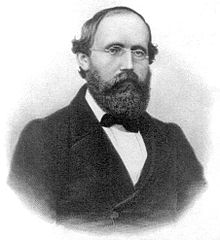
Considered a pioneer of modern theory around the zeta function: Bernhard Riemann

Bernhard Riemann's original work
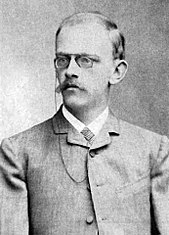
David Hilbert formulated 23 mathematical problems, the eighth of which was the Riemann conjecture
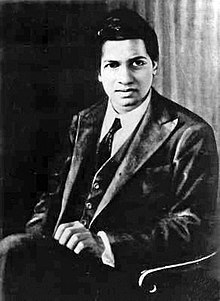
Had self-taught enormous knowledge of zeta function: Srinivasa Ramanujan

Considered one of the 20th century's leading experts in the field of random matrices: Freeman Dyson

Initially became involuntarily involved in a conversation with Dyson at the insistence of Sarvadaman Chowla: Hugh Montgomery

Found that his greatest mathematical discovery was "Ramanujan": Godfrey Harold Hardy
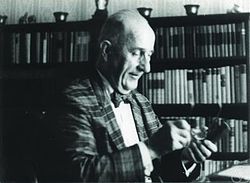
Was able to comprehensibly prepare large parts of Riemann's preserved records for posterity: Carl Ludwig Siegel

Euler's explicit calculations in his original work De Summis Serierum Reciprocarum
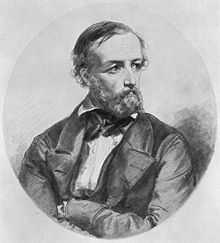
Peter Dirichlet showed with the help of the zeta function that number sequences such as 1, 5, 9, 13, 17, 21 ... or 7, 107, 207, 307, 407 ... contain an infinite number of prime numbers.

Leonhard Euler, 1753
Practical areas of application
Applications with practical relevance are given below. Relationships to basic mathematical and physical research can be found below in the areas:
- Analytic number theory
- Algebraic number theory
- Automorphic shapes
- Geometry
- Probability theory and statistics
Fast primality tests
→ Main article: Miller-Rabin test
A prime number test is an algorithm that checks whether a given number 









The location of the zeros of the Riemann zeta function plays a role in proving the existence of faster prime tests. Under the assumption of the Generalised Riemann Conjecture, Gary L. Miller was able to show in 1976 that there is a deterministic prime number test which in 



In 1980, Michael O. Rabin succeeded in transforming this into a probabilistic test which, although it never gives a result that is 100 per cent correct, is very reliable after a sufficient number of steps. This works independently of the Riemann conjecture.
→ Main article: RSA cryptosystem
Large prime numbers are used in the encryption of data (for example on the internet). The security of such systems is based on the assumption that there is no fast way to decompose a number into its prime factors. In the RSA cryptosystem, a person who wants to encrypt a message takes two large prime numbers 









Physics
In physics, the Riemann zeta function plays a versatile role. Applications have special function values, for example:
- The value
is required, among other things, in the calculation of the critical temperature for the formation of a so-called Bose-Einstein condensate and in spin wave theory for magnetic systems.
- The value
is needed in the high temperature limes in the density of states for the harmonic oscillator.
- The value
is used in the density of states for a free boson gas.
- The constant
to the integral over the radiance of Planck's blackbody radiation.
In addition, the so-called zeta function regularisation plays a role in the regularisation of divergences in quantum field theory. Similar to what Ramanujan did, finite values are assigned to divergent series. An application example of such a regularisation concerns the Casimir effect.
Ramanujan and Euler's formula for 
Zipf's Law
→ Main article: Zipf's law
Zipf's law was originally formulated in quantitative linguistics and states that in a corpus of natural language utterances, the frequency of a word is inversely proportional to its rank in the frequency table. Thus, the most frequent word will occur approximately twice as often as the second most frequent word, three times as often as the third most frequent word, and so on. Using 
with the harmonic sequence 


describe. In the case of the zeta distribution suitable for "infinitely many words" 
Properties of the Dirichlet series
For real arguments σ 
Imaging properties and conclusions
On the open interval ![{\displaystyle ]1,\infty [}](https://www.alegsaonline.com/image/72b3bf6467fe04b9074d5c99b73a8edd26f402f1.svg)
![{\displaystyle ]1,\infty [}](https://www.alegsaonline.com/image/72b3bf6467fe04b9074d5c99b73a8edd26f402f1.svg)
![{\displaystyle ]1,\infty [}](https://www.alegsaonline.com/image/72b3bf6467fe04b9074d5c99b73a8edd26f402f1.svg)
Since ![{\displaystyle \zeta (]1,\infty [)\subset \mathbb {R} }](https://www.alegsaonline.com/image/eb64ceb8de7bfcaafeda08aa1fc62c446764f1b0.svg)


Inequalities
The real Dirichlet series can be enclosed in its convergence region by rational functions. For all σ 
Also interesting in this area is the inequality
Convergence speed
If we define 
where 


Behaviour in the vertical and horizontal direction
For real parts that increase indefinitely, the zeta function has an asymptotic behaviour that is easy to determine; the following applies
This follows directly from the uniform convergence of the Dirichlet series in the domains 
For any σ
for all 
This estimation is optimal. With the Euler product and Kronecker's approximation theorem, the following statements can also be made
prove. Also with approximation methods it can be proved that for every 
holds. Regarding the averages on vertical lines, Turganaliev showed in 1981 for all σ 
Here the coefficients generate 

Relationships to number theoretic functions
The Dirichlet series of some elementary and important (very often multiplicative) number-theoretic functions can be expressed via the Riemann zeta function. Of great importance here, for example, is the observation that the multiplicative inverse of the zeta function can again be represented by a Dirichlet series. The formula applies
where μ 




i.e. the reciprocal of the Euler product, and forms the associated Dirichlet series by consistent multiplication out.
The Dirichlet convolution for number theoretic functions is a homomorphism from the ring 

with the divisor function σ 
with the Eulerian phi function. There is a whole galaxy of other identities beyond that. For example, the formula
can be traced back to Ramanujan. These identities testify to a close connection between number-theoretic functions on the one hand and a function endowed with good analytic properties such as global meromorphism on the other. By means of methods of analytic number theory, often striking behavioural patterns of these number-theoretic functions can be proved. Two important techniques for this, the Selberg-Delange method and the use of dew theorems, are described in this article.
Dirichlet series of derivatives and root function
Its 

This follows by means of limb-wise differentiation, which because of uniform convergence of the series on compact subsets 
Special function values
Function values for even natural numbers
Properties
The function values of the Riemann zeta function for positive even numbers have a close relationship to the circle number π 

where 






Derivation to Euler's formula
Euler was inspired in his considerations by the Taylor series of the cardinal sinus. Via comparison of the coefficients on both sides, where on the right side first multiply out,
he concluded, for example
An alternative and more direct access to the values at even places is provided by the cotangent function. On the one hand, its infinite partial fraction decomposition yields the power series
on the other hand follows via the complex sine and cosine
By comparing the coefficients of both power series, Euler's formula is obtained.
More formulas
The recursion formula applies
for natural numbers 
Application
Although the Bernoulli numbers are rational, their explicit calculation for increasing indices is difficult, since initially only elaborate recursion formulae are available. For a long time, therefore, Euler's formula was valid for the values 

Function values for odd natural numbers
Very little is known about the value of the zeta function for odd natural numbers. The reason for this is that all known methods for explicitly determining values 

which 



Apéry series
In essence, Apéry used for the proof of the irrationality of 
with rational links. On the other hand, it also applies
Series of this kind are also called Apéry series. In the desire to be able to apply Apéry's proof method to other zeta values if necessary, these are still the subject of intensive research today. Contributions were made by Ablinger, Bailey, Borwein, Sun and Zucker, among others. When attempting a generalisation, one naturally encounters connections to general harmonic sums and multiple polylogarithms. However, despite formulas such as
the breakthrough has still not been achieved.
Linear independence over 
After all, it is known that infinitely many values 

holds. From this inequality it follows that infinitely many values of the set 





Periods to ironstone series
Ramanujan gave the identity


an. The posterior polynomial in α 





and more generally a representation that includes zeta values of even arguments:
Ramanujan's formula can be shown, for example, by applying the residue theorem to the function 
are just the Eichler integrals to Eisenstein series of weight 




At the same time, however, they proved that the amount
contains at most one algebraic number, where 





Numerical calculation
Especially for smaller values 



Other fast convergent series, available for all values 
Here 


The decimal places of some values 
| 2n + 1 | ζ(2n + 1) | OEIS episode |
| 3 | 1,2020569031595942853997381… | Episode A002117 in OEIS |
| 5 | 1,0369277551433699263313654… | Episode A013663 in OEIS |
| 7 | 1,0083492773819228268397975… | Episode A013665 in OEIS |
| 9 | 1,0020083928260822144178527… | Episode A013667 in OEIS |
| 11 | 1,0004941886041194645587022… | Episode A013669 in OEIS |
| 13 | 1,0001227133475784891467518… | Episode A013671 in OEIS |
| 15 | 1,0000305882363070204935517… | Episode A013673 in OEIS |
| 17 | 1,0000076371976378997622736… | Episode A013675 in OEIS |
| 19 | 1,0000019082127165539389256… | Episode A013677 in OEIS |
Function values for non-positive integers
In contrast to the zeta values of positive whole arguments, about which almost nothing is known to date in the case of the odd values, the function values for non-positive integers are all known. It is known, for example, that they are all rational numbers. Like the zeta values of even positive numbers, they are very closely related to the Bernoulli numbers.
Via the integral formula derived with a Hankel contour
is deduced by inserting a non-positive integer 
Here 
Among other things, this gives 
In his blog, mathematician Terence Tao goes into the "formulas"
in detail. In particular, it explains that these equations make sense outside of the traditional calculation of infinite series and that the results to the right are even "uniquely determinable". Tao writes about this:
"Clearly, these formulae do not make sense if one stays within the traditional way to evaluate infinite series, and so it seems that one is forced to use the somewhat unintuitive analytic continuation interpretation of such sums to make these formulae rigorous."
"It is clear that these formulae make no sense if one stays within the traditional way of evaluating infinite series, and so it seems that one is forced to use the somewhat unintuitive interpretation by analytic continuation of such sums to make these formulae rigorous."
- Terence Tao
Function values for half-integer arguments
The following applies to the function values for half-integer arguments:


Ramanujan gave in his diary the following series identity 

This was taken up by some mathematicians and further generalised. For example, Kanemitsu, Tanigawa and Yoshimoto found similar identities 


In 2017 Johann Franke gave the following identity for half-integer function values:
with





Here σ denotes 
Zeros
Trivial zeros
From the representation as an Euler product one can easily conclude that 


Non-trivial zeros
Besides the trivial zeros, the zeta function has further zeros in the critical strip 
one can at least conclude that 
Existence and asymptotic distribution
Due to the Euler product and the functional equation, all non-trivial zeros must lie within the closed critical strip 
"The number of roots of
whose real part
lies between
and is approximately
because the integral
extends
positively around the integral of the values of , whose imaginary part
lies between
and
whose real part lies between
and is (except for a fraction of the order of the size
) is equal to
; but this integral is equal to the number of roots of
lying in this area."
- Bernhard Riemann
Riemann thus gave a formula for the asymptotic distribution of non-trivial zeros for the first time in his work. He claimed that the number 

He justified his train of thought (as briefly described above) via an evaluation of the zero-counting integral
where ξ 


where because of all the symmetries of ξ can 
![{\displaystyle L=[2,2+\mathrm {i} T,1/2+\mathrm {i} T]}](https://www.alegsaonline.com/image/0bfb92a3ff7662bb4a0176ecfeef47757d05948f.svg)

While most of the factors of the ξ 

The error 



Symmetry properties
The functional equation of the zeta function and its basic mirror property with respect to conjugate arguments imply a pairwise occurrence of the non-trivial zeros. If, for example, ρ 
also 





However, if the Riemann conjecture is correct, all zeros lie on the straight line 


Sums and series
The identity applies
Here γ 

This formula is required in deriving the explicit remainder estimates (also assuming the Riemann conjecture) of the prime number theorem.
Orders
Little is known about the order of the non-trivial zeros. It is assumed that all zeros of the zeta function have order 1. This assumption is supported by numerical investigations: So far, all zeros found were of first order.
However, J. B. Conrey, A. Ghosh and S. M. Gonek found statements under the assumption of the Riemann conjecture and the generalised Lindelöf conjecture. The latter states that for all ε 



Assuming both, we obtain for the number of simple zeros 
In 2013, H. M. Bui and D. R. Heath-Brown were able to show that this can essentially be proven without Lindelöf's conjecture. Furthermore, for values
where over zeros ρ 
![{\displaystyle [T,T+T^{{\frac {1}{2}}+\varepsilon }]}](https://www.alegsaonline.com/image/437132acf3e12c88d83118871dcb34a0f6f9f853.svg)
According to a conjecture by Hardy and Littlewood, for every ε there exists 



![{\displaystyle [T,T+T^{{\frac {1}{4}}+\varepsilon }]}](https://www.alegsaonline.com/image/3f8091c1d16cc2320a5afa794ddac690a50d5726.svg)

holds. Here 
![{\displaystyle [0,H]}](https://www.alegsaonline.com/image/87538f158ae428e042d3889ef0f71fa3db85f037.svg)
In the case that all zeros should be simple, the non-vanishing values 

Here μ 
Zero-free regions
Already at the end of the 19th century it could be shown with the help of a simple proof of contradiction that the zeta function has no zeros on the straight line 


This zero-free region could then be enlarged further and further. Thus it was shown that a constant 

has a zero. Such improvements lead (in generalised form for Dirichlet L-functions), among other things, to the Siegel-Walfisz theorem.
The sharpest zero-free region to date, obtained with great technical effort, is given for 
This leads to an improved error in the prime number theorem: For a constant
An explicit value for the constant in the error function, namely 


The Riemann conjecture
→ Main article: Riemann conjecture
Riemann conjectured in 1859 that all non-trivial zeros on the straight line 

The location of the zeros in the critical strip is closely related to statements about the distribution of the prime numbers. For example, the statement that there are no zeros on the edge of the critical strip is a possible intermediate step in the proof of the prime number theorem. In other words, the zeros encode the deviation of the prime number function π 






However, if all zeros lie on the mean straight line 


It should be noted that 
Atle Selberg gave the following assessment in 1946:
"I think the reason we believe so readily in the correctness of the Riemann conjecture is that it is the most beautiful and simplest distribution for the zeros that we can imagine. There is this symmetry along the critical straight lines. It would also result in the most natural distribution of primes. Somehow we would like to believe that at least something in this universe should be right."
- Atle Selberg, 1946
Results for the position on the critical straight line
In 1914 Godfrey Harold Hardy was able to show that infinitely many non-trivial zeros lie on the critical straight line 

only assumes real function values. This simplified the problem to the existence of infinitely many zeros of a real-valued function to be solved. The proof by contradiction (see Reductio ad absurdum) shows that ξ 



In 1921 Hardy, together with his friend and colleague John Edensor Littlewood, improved the statement to the much stronger result that for sufficiently large values 



Atle Selberg improved this result in 1942 to 

For this and other contributions he was honoured with the Fields Medal in 1950. From this point on, work was done to find the highest possible values for
In the early 1970s Norman Levinson was able to show that at least one third ( 


Numerical calculations
See also: Calculation of zeros of the Riemann zeta function
Early on, there were efforts to verify the Riemann conjecture and other phenomena by explicit numerical calculations. The methods improved explosively, especially in the age of powerful computers. So far, all non-trivial zeros found lie on the straight line 
Numerical values of the early zeros
→ Main article: List of non-trivial zeros of the Riemann zeta function
The imaginary parts of the "first" zeros are for example
| ±k | ±Im(ρk) | ±k | ±Im(ρk) |
| 1 | 14,134725141734693790… | 11 | 52,970321477714460644… |
| 2 | 21,022039638771554993… | 12 | 56,446247697063394804… |
| 3 | 25,010857580145688763… | 13 | 59,347044002602353079… |
| 4 | 30,424876125859513210… | 14 | 60,831778524609809844… |
| 5 | 32,935061587739189690… | 15 | 65,112544048081606660… |
| 6 | 37,586178158825671257… | 16 | 67,079810529494173714… |
| 7 | 40,918719012147495187… | 17 | 69,546401711173979252… |
| 8 | 43,327073280914999519… | 18 | 72,067157674481907582… |
| 9 | 48,005150881167159727… | 19 | 75,704690699083933168… |
| 10 | 49,773832477672302181… | 20 | 77,144840068874805372… |
Nothing is known to date about the properties of these imaginary parts (irrationality, transcendence ...).
Hadamard product development
In addition to the Euler product, there is another product representation of the zeta function that for the first time directly includes its zeros in a possible definition. This is so significant because it is the key to the connection between prime numbers and zeros. Indeed, the decisive step in Bernhard Riemann's work was the "comparison" of these two products, which ultimately implies a close relationship between the product elements (in this case prime numbers and zeros). Because of its low convergence speed, however, the product representation is not suitable in practice as a basis for a numerical calculation algorithm for the zeta function.
Using Hadamard's product theorem for holomorphic functions, it is possible to reconstruct the zeta function using its zeros via a product. In doing so, it is exploited that the whole function ξ 


Here 


A somewhat simpler (but only conditionally convergent) form of the Hadamard product is
Absolute convergence results if the zeros are ordered "pairwise". Thus the factors 


Atle Selberg

Jacques Salomon Hadamard
The real part of the function 
Besides the trivial zeros at 



Other properties in the critical strip
Voronin's universality theorem
According to Voronin's universality theorem, the Riemann 
As an illustrative comparison, imagine that for every holomorphic function there is a kind of "map" that represents the heights and depths as well as the compass direction of the function values in the complex plane. The universality theorem now states that if one were to scan the map of the zeta function in a certain infinite area, sooner or later one would come across areas that arbitrarily resemble sections of the maps of other functions, i.e. together with all the "mountains" and "valleys" entered in them. The only prerequisite here, however, is that the value 0 is never entered on the map section of the foreign function.
Formally expressed: Let 





for all 






Even more is true: the lower asymptotic density of all 
proves. Here λ is 






A similar result is found for the lower asymptotic density. Note that in this version the modified function 
This astonishing property entails some consequences. For example, it can be shown that the Riemann zeta function does not obey any algebraic differential equation. More precisely, one can show that if 



then it already follows 


always dense in 
Approximate functional equation
Although the Dirichlet series no longer converges in the critical strip, its partial sums can lead to a good approximation of the zeta functions. A very simple formula of this type, valid for 
For fixed values the error becomes




by adapting the summation range to the argument. Thus the zeta function in by the first | 

Again, a corresponding approximation in the critical strip is to be expected and combining both results, with 


which is also called Approximate functional equation. This was discovered in 1921 by Hardy and Littlewood, but as it turned out later, it was already known to Bernhard Riemann. It is a powerful tool for investigating the zeta function in the critical strip.
Growth in the critical strip
Known results
With the approximate functional equation it follows via
In 1958, Korobov and Vinogradov estimated the
with a 

Richert gave a more explicit form in 1967:
From these results, the largest known zero-free region of 
and
The Lindelöf presumption
→ Main article: Lindelöf's conjecture
For all real σ the size is
finite. The notation μ 














The exact values of μ 







Nevertheless, one can 
One can also show that μ 
Lindelöf's conjecture is equivalent to the fact that equality always holds in the last inequality. Because of the convexity of μ 

Relationship to moments of power
The number-theoretical significance of Lindelöf's conjecture becomes apparent through a connection to the power moments of the zeta function along the critical straight line. If one defines
then it is equivalent to the statement 

and Heath-Brown showed in 1979
with 



Connection with the Riemann conjecture
There is a relationship between the growth of an analytic function and the number of its zeros because of Jens' formula. In fact, Lindelöf's conjecture holds exactly if for all holds:
This was first proved by Backlund in 1918. If the Riemann conjecture is correct, the numerator would always be 0, with which the Lindelöf conjecture follows directly. However, the validity of the Riemann conjecture cannot be deduced from the Lindelöf conjecture, since a single non-trivial zero with a real part unequal to 
In the event that the Riemann conjecture is true, Littlewood showed
with a positive constant Soundararajan showed that can be set.
Study on quantum optical methods
The course of the zeta function in the complex plane, especially along stripes running parallel to the imaginary axis, is also specifically investigated experimentally with quantum optical methods in the 2000s, namely with interference methods analogous to holography, because of the connection with the prime number distribution and the so-called factorisation problem directly affected by it. For this purpose, one divides the defining sum into two parts with positive and negative phase, ψ 

The course of the (Lindelöfian) μ 


Any holomorphic function 

Complex diagram with colouring of the function values: The zeta function behaves very chaotically in the critical strip. Here is a section for

Ernst Lindelöf
Application in analytic number theory
Relationship to the prime number distribution
The prime number theorem
→ Main article: Prime number set
As the 15-year-old Gauss already suspected, the number of all primes π 


However, this so-called prime number theorem was not proved independently by Hadamard and Poussin until a hundred years later. For a proof, the identity valid between the Riemann zeta function and the prime function can be used.
which finds its origin in the Euler product. If we now know that 






Here denotes 
Explicit calculation of the prime number function
From the unconditional convergence of the Euler product it follows immediately that 



by means of an inverse Mellin transformation. The sum on the left-hand side yields for each prime power 





where 


Here μ 






Riemann interpreted the "real principal part" of his formula as a better approximation than 

"The well-known approximation formula π
is therefore only correct up to quantities of the order
and gives a somewhat too great value; for the non-periodic members in the expression of
are, apart from quantities which do
not grow to infinity with
. In fact, the comparison of
with the number of prime numbers under carried out by Gauss and Goldschmidt and continued up to
= three million has
always shown this number to be smaller than
from the first hundred thousand onwards, and indeed the difference grows under some fluctuations gradually with
. But also the local condensation and dilution of the prime numbers, which depends on the periodic members, has already attracted attention in the counts, without, however, a regularity being noticed in this. In a possible new count, it would be interesting to follow the influence of the individual periodic elements contained in the expression for the density of the primes.
- Bernhard Riemann
The function addressed by Riemann
is nowadays called the Riemann R-function and for the first values 




for all (sufficiently large) 
The Selberg-Delange Method
→ Main article: Selberg-Delange method
The Selberg-Delange method is a technique to determine the mean order of a number theoretic function as long as its generated Dirichlet series has sufficiently good properties. Here, one makes use of complex powers of the zeta function. For 

Let 




can be estimated explicitly. The error depends on the size of the zero-free area of 


An application example of the Selberg-Delange method is a result by Paul Bateman concerning Euler's phi function. This states that the number of natural numbers 

where 

The Dirichlet divider problem
→ Main article: Dirichletian divisor problem
Lindelöf's conjecture is already a number-theoretic statement. It can be used to describe the nature of divisor sums in quite some detail. These sums are the subject of Dirichlet's divisor problem, which, in the classical variant, searches for the magnitude of the sum
where 

with β



This problem can even be generalised. For this one defines
While 






With the help of the power moments of the Riemann zeta function, the general statement
can be taken. The term 








Product compositions
A product composition of the natural number 






This was used by László Kalmár to develop the following asymptotic formula 
Here κ 

![{\displaystyle ]1,\infty [}](https://www.alegsaonline.com/image/72b3bf6467fe04b9074d5c99b73a8edd26f402f1.svg)
Determination of the mean order of number theoretic functions via Dewer theorems
→ Main article: Wiener-Ikehara Theorem
Dew theorems for Dirichlet series 

already deduce that the associated Dirichlet series on a half-plane 




Thus it follows from 
For the phi function,
A good tool for deriving these identities is Delange's Taubersatz. In the case that the considered number theoretic function is just indicator function of a subset 

Approximation of the prime function in the interval ![{\displaystyle [200,230]}](https://www.alegsaonline.com/image/1884c22cdb2645fd00f8f1ed07a035343a2a3673.svg)

Over long distances the function 


Application in algebraic number theory and generalisations
Dirichlet L-functions
→ Main article: Dirichlet L-function
The Riemann zeta function is a special Dirichlet L-function. It corresponds to the so-called trivial character χ 

Relationship to the Dedekind zeta function of number fields
→ Main article: Dedekind zeta function
The Dedekind zeta function 













In order to re-establish uniqueness, the transition is made to the ideals of 

which decays into an Euler product over the prime ideals:
Here the natural number denotes 


The function 



The number body 
In the case 


Square Number Bodies
Is 




where denotes 
An important special case is 
where the Dirichlet beta function β corresponds to 


Via a coefficient comparison, one can thus 


Circular divider
If 

The product passes through all primitive characters modulo 






Abelian extensions
In the case that 


Quaternions and octaves
Using the Cayley-Dickson method, one can determine Dirichlet series from the quaternions and octaves, which 

and also
From this follows directly, among other things, the four-square theorem and Jacobi's theorem.
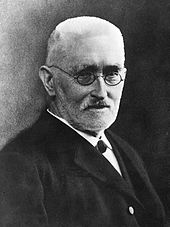
Richard Dedekind
Connections to the theory of automorphic forms
In the theory of modular forms, which are important for number theory, the Riemann zeta function appears in a few places.
 -functions to ironstone series
-functions to ironstone series
For weights 

The latter expression is a representation as a Fourier series. This is characteristic for modular forms. Due to the normalisation by means of the factor 



In 1987 Frits Beukers was able to prove the irrationality of 
which 

The argument ultimately refers to a technique that exploits radii of convergence of inverse functions of locally injective meromorphic functions. The same method can be used to find 



Relationship to non-holomorphic ironstone series
For complex numbers 


absolute. The function defined by this is non-holomorphic and also (for fixed 





This parallel to the theory of the zeta function already suggests a connection. The representation applies
where Γ 

so applies
Non-holomorphic Eisenstein series, and thus the zeta function itself, play a fundamental role in the so-called Rankin-Selberg method, which has emerged as a powerful tool in investigations within the Langlands programme.
Relationship to the Jacobian theta function
A very important property of the Riemann zeta function is its functional equation. This is expressed most simply via
and note that on the right hand side, amazingly, the complex variable is 
There are several derivation variants for finding this equation. Riemann already showed two different ones. One of them includes a simple special case of the Jacobian theta function
directly with it. Of advantage is the modification ψ 



The starting point is the integral representation
The following trick is a standard transformation in the proof of Heck's inverse theorem. By splitting the integral into the intervals 
![[0,1]](https://www.alegsaonline.com/image/738f7d23bb2d9642bab520020873cccbef49768d.svg)

The second integral can be calculated elementarily:
As one can easily see, the right side is unchanged under the mapping 

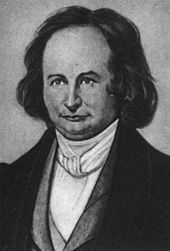
Carl Gustav Jacobi
Geometric aspects
Volumes of special geometric figures
The values of the Riemann zeta function at positive even places are rational multiples of corresponding π 
For example, they appear in the formula for the symplectic volume of the fundamental domain 

In the simplest case 

Beilinson's assumption



Here is 




This discovery by Armand Borel had a great impact on further research and gave deep insights into the arithmetic nature of zeta and L values. These were eventually unified in the so-called Beilinson conjecture. Spencer Bloch and Kazuya Kato gave a complete description of the values 

Relationships to elliptic curves and congruent triangles
→ Main article: Elliptic curve
The (global) Hasse-Weil 

where 

→ Main article: Congruent number
A triangle is called congruent if it is right-angled, has only rational side lengths and an integer area 






Arithmetic zeta functions
The zeta function of a scheme 
The product passes through all closed points of the schema, i.e. those whose associated residue class body is finite. 


The right-angled triangle has rational side lengths of 3, 4 and 5, but an integer area of 6. Therefore 6 is a congruent number.
Occurrence in probability theory, statistics and probabilistic number theory.
Partial alien tuples
Some probability laws from number theory are also closely related to the zeta function. The probability that a randomly chosen number is square-free, and likewise the probability that two randomly chosen numbers are divisor-alien, is equal to

More generally, is 


Relationships to the theory of random matrices
In 1972, during a tea break at the Princeton Institute for Advanced Studies, mathematician Hugh Montgomery described his model for the pair correlation of zeros of the zeta function to a colleague, quantum physicist Freeman Dyson. Assuming the Riemann conjecture, the non-trivial zeros ρ 
considered. Together with 


![{\displaystyle \textstyle {\frac {1}{W}}\#\{(w_{n},w_{m})\in [0,W]^{2}|\alpha \leq w_{n}-w_{m}\leq \beta \}}](https://www.alegsaonline.com/image/6eb3ed818451d65f3a96a90de8eab7c57e37b8e9.svg)
can be studied. The following theorem of Montgomery, proved under the assumption of the Riemann conjecture, classifies the asymptotic behaviour of 



![{\displaystyle K\subset [-1,1]}](https://www.alegsaonline.com/image/a18fdd6af76bddebfc3cd880e55dce611821b342.svg)
Dyson, one of the founders of the theory of random matrices, immediately recognised a connection. Namely, if 




Here μ denotes 



Keating-Snaith conjecture
Keating and Snaith have formulated a conjecture about the asymptotic growth of the power moments 
with the arithmetic factor
and the matrix factor
To understand the way to this assumption and its relation to statistics, the following very heuristic argument is helpful. Assuming that all primes are "independently distributed", it follows by means of Euler product for the expected value (with respect to the Lebesgue measure 
![{\displaystyle [1/2,1/2+\mathrm {i} t]}](https://www.alegsaonline.com/image/182683c3331fbad46c5d6fa63a2657802fcf063a.svg)
and from this one ultimately obtains the terms given by Keating and Snaith, whereby the matrix factor is only a correction term within this "independence model".

Nina Snaith
Algorithms for fast numerical calculation
→ Main article: Calculation method for the Riemann zeta function
For a quick numerical calculation of the function 
Euler-Maclaurin molecular formula
A good and historically early used method turns out to be the "aborted" summation formula, which is obtained with the help of the Euler-Maclaurin summation formula. In general, an arbitrary natural number 

The following applies to the remainder
With the (free) choice of 




Moreover, by applying the functional equation (a quick calculation of the gamma function and the exponential function π 

Alternating sums
A method using broken alternating series was developed by Borwein. This uses the formula valid for 
where 


Calculation on the critical straight line
Riemann Seal Formula
Many methods lose precision if the imaginary part of the argument is chosen very large, which is problematic when searching for zeros along the critical straight line. Therefore, other methods are used here, one of which is the Riemann-Siegel formula. This can be derived via the Riemann-Siegel 
Here θ 

The error term 
can be improved at will. The terms 

Proceedings of Odlyzko and Schönhage
→ Main article: Proceedings of Odlyzko and Schönhage
In 1988, A. M. Odlyzko and A. Schönhage developed a very fast method to determine values of the Riemann zeta function on the critical straight line. This is based on the ideas of the Riemann-Siegel formula, but only requires instead of 

Other expressions for the zeta function
In addition to its elementary row representation, the zeta function has a rich array of other expressions, some of which are listed below.
Row representations
Worth mentioning is the series expression

which is 


From Helmut Hasse comes the globally convergent series
Blagouchine gave numerous variations and generalisations of such series types in 2018.
Integral representations
An exotic and globally convergent expression is obtained by directly inserting the elementary row representation of the zeta function into the Abel-Plana summation formula:
Quite similarly, for example

whereby, however, the integral converges restrictively only for 
An overview of numerous other integral representations comes from Michael S. Milgram.
Sum formulae
To derive a globally valid summation formula, in the case of the Mellin transform, the integrand is an 
This fact creates a close relationship between the zeta function and the Bernoulli numbers 


This exploits the fact that 
Relationships to other special functions and further generalisations
In the desire to generalise or vary the definition of the Riemann zeta function, numerous related functions were introduced and investigated. Often these also bear the name "zeta function", connected with the name of their "discoverer". Against this background, reference should also be made to the list of Zeta functions.
Connection to other Zeta functions and Dirichlet series
It applies
where η 

→ Main article: Hurwitz zeta function
The Hurwitz zeta function is defined for 
For fixed 



With the help of the Hurwitz zeta function, the Riemann zeta function and the Dirichlet L-functions can be treated uniformly. This is particularly useful with regard to their generalised functional equation.
→ Main article: Lerch's zeta function
Even more general than the Hurwitz zeta function is the Lerch zeta function, which for 


It then applies
The far-reaching definition of Lerch's zeta function not only allows specialisations to the Hurwitz and thus also to the Riemann zeta function, but also includes many other important functions as special cases. Similarly defined "generalised zeta functions" are also used in theoretical physics, namely in connection with the systematic so-called semiclassical approximation of quantum mechanical results.
→ Main article: Primzeta function
For all 
where 

This allows an (analytical) continuation of the prime function into elementary areas of the half-plane 


Furthermore, it follows from 


Relationship to the polylogarithm
→ Main article: Polylogarithm
The polylogarithm generalises, among others, the natural logarithm and is given for 
Furthermore, if 





but also
for values 


Relationship to the polygamy function
→ Main article: Polygamma function
The function 






For the digamma function
and generally for natural numbers
At first sight, this creates a connection to the theory of polygamma functions, which arise from the derivatives of the function 










valid in the range However, this generalisation does not use fractional infinitesimal calculus. Such an approach was taken by Grossman.
Values of the Riemann zeta function also appear as function values of the polygamma function. Worth mentioning in this context is a set of formulae which for any natural 
Derivative
In recent decades, there has also been increasing 
The function 


Although the derivative does not have a representation as an Euler product, there are also connections to the primes here. Such a formula can be obtained by means of logarithmic derivation, i.e. via the identity
Set here
for the 
The zeros are also of number-theoretical interest for the derivation. Thus the statement 

Where 

For all negative integers 
Other values are
where 
In Art and Culture
In the film The Poetry of Infinity, the Euler product development of the Riemann zeta function is written on a board in the background of Godfrey Harold Hardy's office.
In Neal Stephenson's novel Cryptonomicon, the Riemann zeta function is mentioned several times in connection with the fictional cryptocodes Azure, Pufferfish and Arethusa.
See also
- Riemann-Siegel theta function
- Multiple zeta function
Search within the encyclopedia




































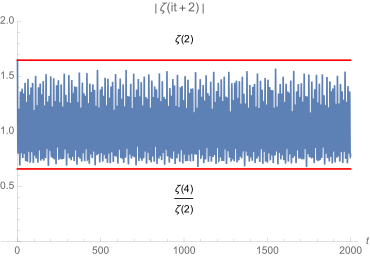




















![{\displaystyle {\begin{aligned}\zeta (3)=&{\frac {5}{105}}\pi ^{2}\log(2)-{\frac {4}{105}}\log(2)^{3}+\\&+{\frac {4}{35}}\sum _{k=0}^{\infty }{\frac {1}{16^{k}}}\left[{\frac {8}{(8k+1)^{3}}}-{\frac {4}{(8k+3)^{3}}}-{\frac {4}{(8k+4)^{3}}}-{\frac {2}{(8k+5)^{3}}}+{\frac {1}{(8k+7)^{3}}}+{\frac {1}{(8k+8)^{3}}}\right].\end{aligned}}}](https://www.alegsaonline.com/image/a7734ffbef62615206ba57ca863331f1c92d9c4d.svg)

















![{\displaystyle N(T)={\frac {1}{\pi }}[\operatorname {Arg} (\xi (s))]_{L}.}](https://www.alegsaonline.com/image/b26a9973f71fad53d2d9b95843fdf91e22f6cc45.svg)
























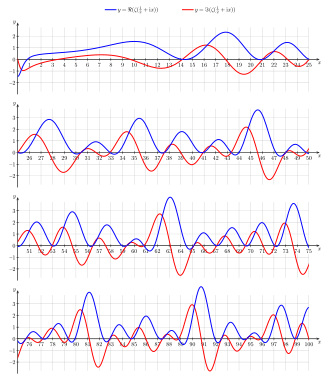
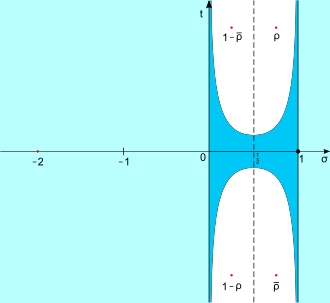
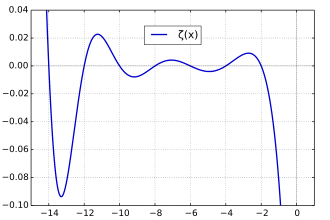
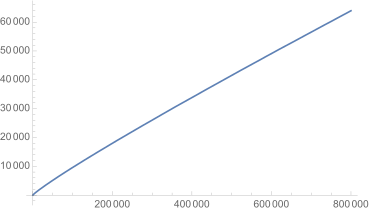

![{\displaystyle 0<\liminf _{T\to \infty }{\frac {1}{T}}\,\lambda \ \left(\left\{t\in [0,T]\mid \max _{s\in U}\left|\zeta (s+\mathrm {i} t)-f(s)\right|<\varepsilon \right\}\right)}](https://www.alegsaonline.com/image/4c262e3b952c9a7862803c3cc296096c057aeffb.svg)

























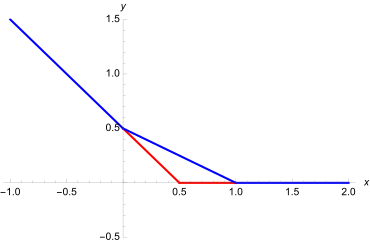
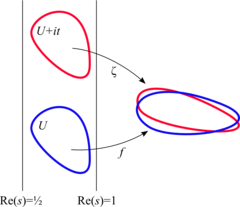





























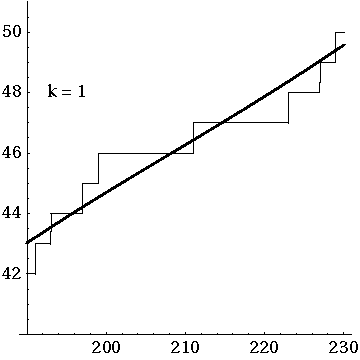
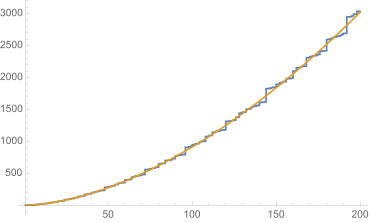


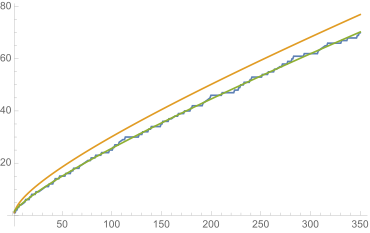
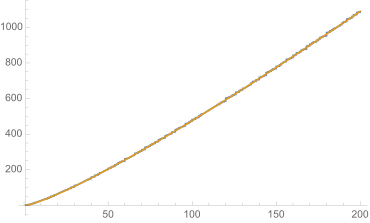























![{\displaystyle {\begin{aligned}\int \limits _{0}^{\infty }\psi (t)t^{s/2}{\frac {\mathrm {d} t}{t}}&=\int \limits _{1}^{\infty }\psi (t)t^{s/2}{\frac {\mathrm {d} t}{t}}-\int \limits _{\infty }^{1}\psi \left({\frac {1}{x}}\right)x^{-s/2}{\frac {\mathrm {d} x}{x}}\\&=\int \limits _{1}^{\infty }\psi (x)x^{s/2}{\frac {\mathrm {d} x}{x}}+\int \limits _{1}^{\infty }\left({\sqrt {x}}\psi (x)+{\frac {\sqrt {x}}{2}}-{\frac {1}{2}}\right)x^{-s/2}{\frac {\mathrm {d} x}{x}}\\&=\int \limits _{1}^{\infty }\psi (x)\left[x^{s/2}+x^{(1-s)/2}\right]{\frac {\mathrm {d} x}{x}}+{\frac {1}{2}}\int \limits _{1}^{\infty }\left[x^{(1-s)/2}-x^{-s/2}\right]{\frac {\mathrm {d} x}{x}}.\end{aligned}}}](https://www.alegsaonline.com/image/d72306b542e9aaf403b627b85695ab872e4b9cff.svg)
![{\displaystyle \Gamma \left({\frac {s}{2}}\right)\ \pi ^{-s/2}\ \zeta (s)=\int \limits _{1}^{\infty }\psi (x)\left[x^{s/2}+x^{(1-s)/2}\right]{\frac {\mathrm {d} x}{x}}-{\frac {1}{s(1-s)}}.}](https://www.alegsaonline.com/image/24db37abc12d8b82b51528b3171dcc24845919f7.svg)





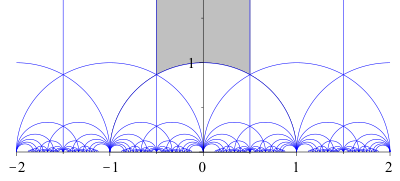









![{\displaystyle {\frac {I_{k}(T)}{T}}=\operatorname {E} [|\zeta (s)|^{2k}]=\prod _{p\ \mathrm {Primzahl} }\operatorname {E} \left[\left|{\frac {1}{1-p^{-s}}}\right|^{2k}\right],}](https://www.alegsaonline.com/image/60496cde5db515ee44c710ee974b0747b6928b30.svg)






























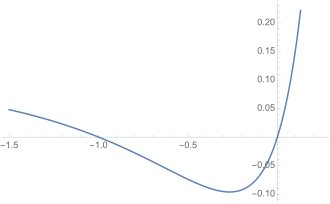








![{\displaystyle \zeta '(-2n+1)={\frac {1}{2n}}\left[(-1)^{n+1}{\frac {2(2n)!}{(2\pi )^{2n}}}\zeta '(2n)+\left(\sum _{j=1}^{2n-1}{\frac {1}{j}}-\log(2\pi )-\gamma \right)B_{2n}\right].}](https://www.alegsaonline.com/image/511cd2052da3fb39764132582607a16a94526c81.svg)
